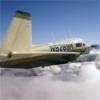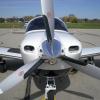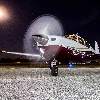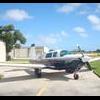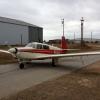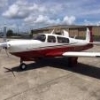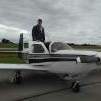Leaderboard
Popular Content
Showing content with the highest reputation on 07/11/2015 in all areas
-
4 points
-
There are lots of methods for assuring the gear is down. But it seems to be the only one that truly needs checking is the last one over the fence. A common theme in gear up landings is being distracted from your "normal" procedure. So it really doesn't matter what your "normal" procedure is if you are distracted and forget. That is why the only gear check needs to be the last thing you do before you land. It is a little hard to be distracted and forget at that point.3 points
-
5 times every landing G Check the GEAR U Undercarriage check M MAKE sure the gear is down P PUT your hand on the gear switch S Make SURE the gear is down3 points
-
Just an update on this "saga". I have been very busy with work and a pressing BBQ island project that has a wife induced deadline for the month of July that has had it's own headaches... so the plane has sat. However, I have been able to break away this week and make a little progress. She has now set a couple of months and this is likely the longest I have gone without flying since I got my ticket. So be it. It is what it is. I now have the new P leads I fabricated and the new Starter wire to the starter solinoid instaled. The Slick Start has now been moved to it's correct location and all the new wiring run to it. I now await IA inspection so I can start the closing up process. New P Leads! Slick Start on the right side of the fire wall!! My new $310 Ignition switch hooked up, awaiting sign off!!3 points
-
Once you pay $1500 for them, the installation and the associated FAA paperwork you will swear that it flies; faster , stalls slower,and is able to maintain directional control while sitting still on the ramp3 points
-
I haven't checked today, I'll go out to the airport later and see if they are still down.2 points
-
I don't see any latest comments, I only see the same old comments they always have had that where transferred from the A/FD. Catalina has been the same for years perfectly safe to land but a little ruff compared to what your used to. See you all at 2 pm.2 points
-
No less than 4 times. Downwind, Base, Final, and short final (threshold). I like the "point" part, and try to do that myself.2 points
-
2 points
-
I just want his love to be returned. Surely there is a place where a photo and discussion of his bird is the order of the day. May he find that place and have a blissful relationship. Or change the name of the sight and the monniker to reflect what it is: Mooney's of all shapes, sizes and age and the other guys that want to hang out with them. Maybe the Courts can force me to love his plane and be inclusive. Surely we can not have a type specific site. That is just wrong. I want a standard tail AND my make of plane to be included in the name of the site. I feel oppressed, my body aches...Perhaps he should sue for damages?2 points
-
Everyone knows that Corrosion-X is a scam. Its snake oil. It doesnt work. Its only hyped and promoted by the people who sell it. Also, theres no conclusive proof that it works. I saw a plane just the other day, treated a few years ago with Corroson-X that had corrosion in the wheel well. Fly it often, I say. Nothing else you can do.2 points
-
Si Senor! ^^^^^This is my understanding of how injectors work on a normaly aspirated engine.1 point
-
Most likely it's okay. Just recharge at a low amperage rate for a couple of days. I've done the same thing before and the RGM recovered fine. I just found out today that I left my overhead lights on and drained mine again. So it's on a trickle charge now. Let me know how yours does and I will do likewise. By the way, the overhead lights are either coming out or I'm building a timer shutoff for them! Lee1 point
-
Personally, I lubricate everything with CamGuard. [emoji13] Sent from my iPad using Tapatalk1 point
-
1 point
-
I've got the 650e installed on my J, and the 500 (tail) as well. My MSC handled paperwork.1 point
-
Iirc the injector mixed air drawn in through that bleed hole to atomize the fuel. My #2 was spraying fuel all over the cylinder and nothing stopped it until I made the air dam. 200 mph air was going past the body and sucking fuel out of it.1 point
-
No, if you run the injectors out of the cylinders they will just make a stream of fuel like a squirt gun. The air flow through the injector nozzle atomizes the fuel stream. The air flow through the injector nozzle is caused by the pressure differential between the vent hole and the intake port.1 point
-
I think that the sheer amount of time that the F-35 has been in development speaks volumes. It's amazing to think back decades ago when manufacturers like McDonnell, Northrup, Grumman, Lockheed et al got it right the first time. While projects by these manufacturers may not necessarily have been on budget, the finished products gave the armed services years of reliable service. I've been hearing about the F-35 for what, twenty years now, and it's still not operational. When was the last time an aircraft had still not entered service a full decade after its maiden flight? Hard to believe when you think that Boeing conceived of, designed, engineered, built, flight tested and received certification of the 747 in three years (yes three) - and it's still in production fifty years later. Lastly, air-to-air combat is a relic of the past. Who are we supposed to go up against, the ISIS airforce?1 point
-
The intake vacuum isn't smooth and constant. Pressure spikes, poth peaks and valleys are generated as the intake valve opens and closes. It's also very unlikely that the fuel flow is steady either due to the changing pressures in the intake. When you accelerate and decelerate fluids quickly the pressure also changes.1 point
-
Starfighter was/is a beautiful piece of aircraft...But those tiny wings and narrow gear wear tough on pilots. Not much room for internal fuel storage. Loved the scene in Right Stuff when Yeager takes one out for a little "joy ride".... Intense.1 point
-
Yeah, got them too. I like them, the plane stalls slower and handles better when flying slow. I don't know if I lost one or two knots, but if so, I still like the real (or psychological) benefits they provide me when landing at high altitude fields or on grass....1 point
-
As far as I know 2pm is still the time. As for the runway, it's been crappy forever, but I haven't noticed it being any worse than normal the last couple times I've been there. Some people seem to think you need tundra tires and a super cub to land there, yet last time I landed (just a few weeks ago) there was a citation and several Mooneys on the ramp.1 point
-
Located in NW Florida. Really don't want a partner, selfish with my toys :-), and I'm always going to be worried of who is flying it. What is involved in pickling?1 point
-
The folks at LASAR use the Mooney recommended way of jacking and they lift the nose with straps to the engine mount, not the engine lift loop. That loop was only designed to support the weight of the engine, not the engine plus the weight of a part of the airplane too. It looks like this- They then put a tail stand, not weight under the tail tie down ring. I like this method because it is very stable when you get in and out of the plane. Having said that, Top Gun Aviation, also an MSC, uses the tub of concrete tail weight method as did Accurate Aviation (not an MSC) when they did the annual on my plane before I bought it. I think SWTA also used the weighted tail method when I was there. Because I already owned an engine hoist and not a tub of concrete, it was a no brainer for me in my hangar.1 point
-
Aaron, I'm not trying to pee in your cheerios on this, but I just don't see how reducing fuel flow does what you say it's doing. The injectors are vented to ambient pressure. When the engine is at full throttle, the fuel pressure at the injectors isn't pushing fuel into the manifold it's merely providing a metered volume of fuel that is drawn in by the constant state of vacuum that exists inside the manifold of a normally running NA engine.1 point
-
Interesting comparison thread. I think fuel, parts, annual, and insurance are somewhat less with my M20C than the F35. Avionics and air to air combat capabilities may be slightly inferior, but not enough to justify the added expense. The long bodies may be a more comparable .1 point
-
Schedule the annual and any other maintenance while you are gone so it is not down while you are there. Schedule so it gets done just before you get back so it is guaranteed to gave a fresh battery and oil.1 point
-
I fabricated an air dam in front of #2 and removed the oil cooler baffle completely. FWIW my #2 has the F injector in it (the largest) and it still peaks first.1 point
-
It depends on the engine. While many run fine with stock injectors (mine does), I've heard that some of the factory new engines have had troubles. I think GAMIs are great, but only if you need them.1 point
-
Just to update everyone on this, Fritz and I met up yesterday at Regensburg. He spent a lot of time showing me around the aircraft and talking about his experiences running and maintaining it compared to his previous F-model. We then went for a flight in the local area so I could experience the handling and control forces and see how the view over the cowling worked out in flight and landing. It was very kind of Fritz to spend so much of his time helping me out. It has helped a great deal in my choice of aircraft. As I discovered, the instrument panel is higher than the J, but it's not really a problem. So it looks like the Ovation is on the shopping list. Many thanks to Fritz for his help and generosity. Despite my best efforts, he steadfastly refused to let me pay towards the flight and to my shame he even paid for the beers afterwards!1 point
-
They help lower stall speed by inducing votexes behind each vane and thereby allowing airstream contact with the upper surface of the wing at higher angles of attack. They do create drag at normal angles of attack. If you look at early LearJets they all had several rows of them just ahead of the ailerons to keep airflow in contact with the ailerons at high speed. ol'man Lear (I met and flew with him on several occasions) called them "screw up fixers) only he used a common 4 letter word instead of a 5 letter word.1 point
-
Quite the opposite of parasitic drag , they increase induced drag , as they decrease laminar separation....and increase lift.....1 point
-
If you want a more balanced opinion read the entries at http://www.fightersweep.com. There is an entry there that describes in more detail what that test flight was all about and that you can't read much into it.1 point
-
Boy, I have to say that I'm relieved for you. I know that was/is a frustrating road to go down.1 point
-
How do you know its just parasitic drag? I think they look nice - they represent the technology to manipulate flow across a wing. I love the look of intricate and clever engineered devices.1 point
-
Yup. I got em'. I do enjoy very good low speed handling. And lower than book stall speed.1 point
-
is the F35 designed to be a one on one dogfighter? I probably sound stupid, but I thought it was designed to be more of a jack of all trades fighter.1 point
-
So here is the ultimate fix... Install a set of turbo injectors, route the vent lines to fitting between the air filter and the servo. This would get you the correct pressures all the time, and besides if it did leak you would never know it.1 point
-
green = sarcasm. I was just quoting an esteemed member of this community who doesnt believe in "snake oil"1 point
-
If GA should avoid training routes, then why was the training route designed nearly right over that airport? And are F16s equipped with AdsB? Why put the onus on GA and additionally assume the c150 didn't have AdsB equipment? It sounds like just another opportunity to push AdsB and try to somehow forget about see and avoid... All pilots.1 point
-
Air Traffic Controller. Currently BNA but start working regional approach end of July (DFW approach). Aspiring mooney owner, hopefully I can find "The One" soon1 point
-
I wouldn't be so sure. My local A&P is a place called Sundance -- they charged me OVER $1000 to replace a tire. I kid you not. Run, do not walk, from that place.1 point
-
1 point
-
The IO550 long bodies get a jacking point on the front left of the engine mount. Interesting way to minimize W&B issues while jacked off the ground... Support under the tail still in the event somebody climbs out onto the tail or into the bagge area... Best regards, -a-1 point
-
I would have to agree. We operate one and it's incredible. It's even capable of intercontinental travel. We recently flew ours from South Florida to Bremen, Germany. 2 stops. West Palm Beach, FL to Goose Bay, Labrador to Reykjavik, Iceland to Bremen, Germany.1 point
-
Ever since that SB came out, I've been very reticent to pull back on the yoke to lift the nose off the ground for takeoff. I sure don't want the tail falling off during a critical phase of flight. I now use an engine hoist to set the proper takeoff attitude, but getting the dang thing off during takeoff roll has been a bitch...especially on our turf runway.1 point
-
My sons, 7 yrs/60# and 9 yrs/75#, are growing fast. My wife & I have discussed the idea of getting "something more comfortable." Having a nice J in the hangar that's paid for is hard to give up, especially when the new ride will gain nothing over my J except more payload...maybe. At nearly 1000# payload capable, the J is magic. It's exactly what my bride & I will want when we're empty-nesters. So, rather than find a temp fix band-aid along the lines of buying someone else's problems, we've decided to stay with what we know and love. We find the J very comfortable, capable and efficient...the true sweet spot of GA. It goes without saying that staying fit & trim (healthy), mods to increase payload, reduced fuel and fewer bags will be our reality for the next few years, but the boys will be grown and gone before we know it. There are alot of hidden costs associated with giving up one airplane for another and every airplane is a series of compromises. There is no one airplane that will fully meet any pilot's needs for his/hers lifetime. One fix is to buy a different airplane every few years (very costly IMHO) and I think many folks follow this path. Another possible plan is to buy an airplane that covers the bases best for you and your given mission...then stick with it and avoid the temptation to eyeball that "greener grass" across the fence. This is the plan we've chosen and we feel the J is the bird for us, although, in our case, an F or a J would work nicely for us.1 point
-
You know, that's the funny thing about this. I have a lot of experience with vintage cars and in my younger years used to drive cars from the '50s and '60s exclusively as my daily drivers. These were all not hot rods, but rather bone stock cars and I prided myself on that. As close to the factory as I could get them. I eventually got fed up with lots of little issues all the time, so I chose a '64 Ford Falcon to be my daily driver and decided to rebuild everything that had anything to do with reliability and getting from point A to B. Custom rebuilt engine to my specs, rebuilt transmission with as many new parts as possible, drive shaft U joints and balance, completely rebuilt rear end with new bearing and seals, all new suspension bushings and joints front and rear, new shocks, all new brakes from the master cylinder on down even all the hardware, all new exhaust including new factory hangars, everything around the engine in the engine compartment was either new, or rebuilt including the steering box. Really the only thing I didn't redo was the original wiring harnesses and and the switch gear in the dash, but everything worked perfectly including the heater defroster that I did completely rebuild. It was a lot of work and with the exception of the engine, automatic transmission and rear end rebuilds, I did all the work myself including installs. This was not a frame off show car, it was a very presentable daily driver. All original paint that still held a shine, decent chrome and bright work, good glass and an 80% original interior that was also still presentable. I did take this car on 500 mile trips. I drove it everyday and anywhere, but you know what? I could still never make it 100% reliable and trouble free like a modern new car. It still had issues time to time. The experience I had with that car had me come to the conclusion you just couldn't make a car from the '60s be as reliable as a car today (actually in the '90s when I came to this conclusion) for lots of reasons and here are a few- Old tech. Even when new, it was not as good as what comes in cars today. Just the advantage of time. Electrical wiring and switches, relays, solenoids, sockets, connectors and bulbs. You really have to commit to those too. All of it. Time and corrosion do as much damage as mileage and repetitive use. The quality of rebuilt components and new aftermarket is just not as good as the factory new and most of the time factory new is just not a possibility on a vintage car. Even NOS parts suffer from aging on a shelf. So in 1995 I sold the Falcon and bought a brand new car. That car served me for the next ten years flawlessly, got way better fuel mileage and I even got an airbag out of the deal! The take away is you can't beat brand new for reliability. So when I signed up for a 1966 airplane, I did so with eyes wide open and a full understanding of what I was getting into. I knew it was going to be vintage cars all over again, but vintage is all I can afford to own. It is what it is. If I don't want these headaches, sell and stop flying. Those are my options. Can't afford new, previously owned, or even 20 years old. It is what it is.1 point
-
Yes and the problem with over reporting bad conditions is you will not believe them when they are actually bad.1 point

